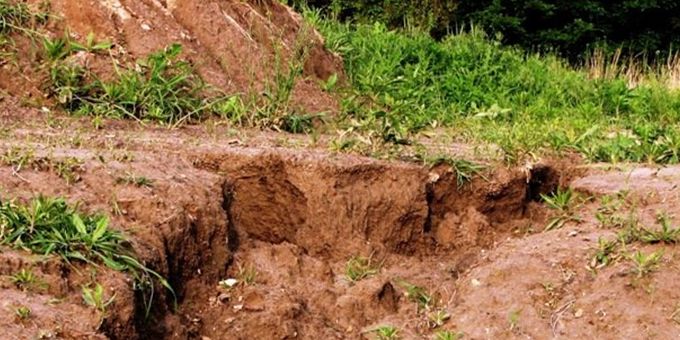Erosion is one risk that workers must mitigate or fix when working with solar panels. These farms can span several acres, with the structures covering most of that land. Underneath it all, the soil and dirt must stay in place.
 Can Erosion at Solar Farms Be Prevented?
Can Erosion at Solar Farms Be Prevented?

Martin Banks | Modded
Solar farms are a sustainable way to create renewable energy. They are a leader in green movements across the world and help countries and communities build an eco-friendly future. However, these farms come with erosion risks. From harsh weather to soil disturbances, solar farms can lose efficiency or cause harm to the surrounding environment.
Luckily, there are steps workers can take before, during and after installation to curb erosion and its effects. That way, the photovoltaic (PV) panels can operate at full capacity, and workers won't have to worry about solely fixing issues after they occur. Prevention, instead of repairs, is the ultimate goal.
What Is Solar Farm Erosion?
Solar energy is one of the key elements of sustainability. To build a better future, renewable energy must be a common resource — overtaking fossil fuels. Among the top renewables, solar and wind power are growing fast in the United States. Despite the environmental benefits of both, though, it's important to take a look at the detriments.
Erosion is one risk that workers must mitigate or fix when working with solar panels. These farms can span several acres, with the structures covering most of that land. Underneath it all, the soil and dirt must stay in place. Otherwise, the structures could shift and become less efficient — or become damaged beyond function.
All forms of solar panel installation and management must include plans for erosion control. Water and wind are two of the biggest culprits of erosion. During high winds or strong storms, topsoil erodes and changes the landscape of the farm.
If erosion exposes the electrical wirings, power failures can occur. If storms bring enough rain, mudslides can happen on a significant slope. Workers must be cautious of flat land, too, since it can cause flooding.
With these potential risks and outcomes, mitigation is necessary. However, that, too, can be tricky due to the environment.
Why Erosion Is Difficult
With the right steps, solar farms can be efficient and fully sustainable. Planning ahead of time, as well as maintenance during and after installation, is key. However, location, setup and environment complicate this monitoring.
The land plays a primary role in solar panel erosion. A sloped landscape can help with water runoff and drainage. Although, if rainfall gets too heavy, the dirt will turn to mud and slide, eroding at all the structures in its path. Depending on the angle, a mudslide can be catastrophic and damaging. Regardless, a slope can cause erosion, no matter what.
Conversely, if the land is too flat, rain can puddle in various locations. That, too, causes its own form of erosion. A compromise between drainage and preventing erosion is necessary.
Workers must also take into account other soil disturbances. For instance, the installation of PV panels disrupts the soil significantly. It involves grading, digging and burying. During these processes, the disturbance causes erosion. However, it creates a landscape where the soil is too loose and, during rainfall or wind, will lead to even more erosion.
Despite these challenges, there are solutions that workers can implement to create a safe, sustainable solar farm.
Ways to Prevent Erosion
Though it can be difficult to plan for all of nature's curveballs, solar farm workers can take different steps to prevent erosion.
Vegetation
One of the main ways to prevent erosion is to work with the right vegetation. For each solar farm, planting depends on circumstances like weather, climate and shaded areas. A solar farm in southern California will look different from one in upstate New York.
Plants and grass have deep roots that secure them to the ground. With heavy rainfall and winds, dirt becomes much harder to erode. Something like hydroseeding — a slurry of seeds and mulch — is key for preventing erosion. Plus, vegetation will retain more water while giving a more appealing visual. People are bound to like grass or plants more than dirt.
Mulch
If vegetation doesn't work on its own, mulch pairs well with it. With a layer of mulch over the topsoil, rain and wind won't easily erode at the landscape and structures. It's heavier and denser than dirt layers. As a bonus, mulch absorbs water at efficient rates — a key benefit for storms.
Of course, there is always the possibility that rain will wash away the mulch. Due to this potential setback, the combination of vegetation and mulch is a helpful path to pursue. Using the two, solar farmworkers have an easier time preventing erosion.
Geotextiles
Geotextiles are fabrics that help with limiting erosion. They can separate materials, protect from harsh conditions and drain when the landscape requires. With such versatile abilities, solar farm workers can lay down geotextiles in large plots of land to keep erosion from happening.
As an example, an erosion control blanket prevents soil from shifting and aids vegetation growth throughout installation and onwards. Workers choose from short-term or long-term blankets. For instance, 80% of the short-term blankets biodegrade after three months, whereas long-lasting ones can stay for up to three years. Vegetation safely takes root while the blanket offers protection.
Drainage
Part of the reason drainage is tricky for solar farms is that runoff can be dangerous. If there are neighboring properties or communities nearby, extreme runoff could eventually lead to flooding. Proper drainage is therefore necessary.
Trenches and barriers can keep water and mud from overtaking roads or pathways. Additionally, low-water crossings, or Arizona crossings, are isolated, bridge-like dirt pathways where water runs underneath. These crossings keep runoff from consuming the path itself.
Additionally, the roads and paths need maintenance. Tightly compact materials like pavement do not absorb water well — it will run right over them. Plantlife, too, cannot take root. Solar farmworkers must focus on preventing water from reaching these areas as well as keeping gravel nearby. That way, there are foils in place for runoff.
Prevention Is Possible
With simple fixes, solar farm erosion prevention is possible. However, these solutions don't necessarily mean erosion will never occur. The best solutions include planning ahead with these steps and with fixes ready for when erosion does happen. That way, solar energy and solar farms can remain a sustainable resource for renewable energy.
The content & opinions in this article are the author’s and do not necessarily represent the views of AltEnergyMag
Comments (1)
Featured Product

